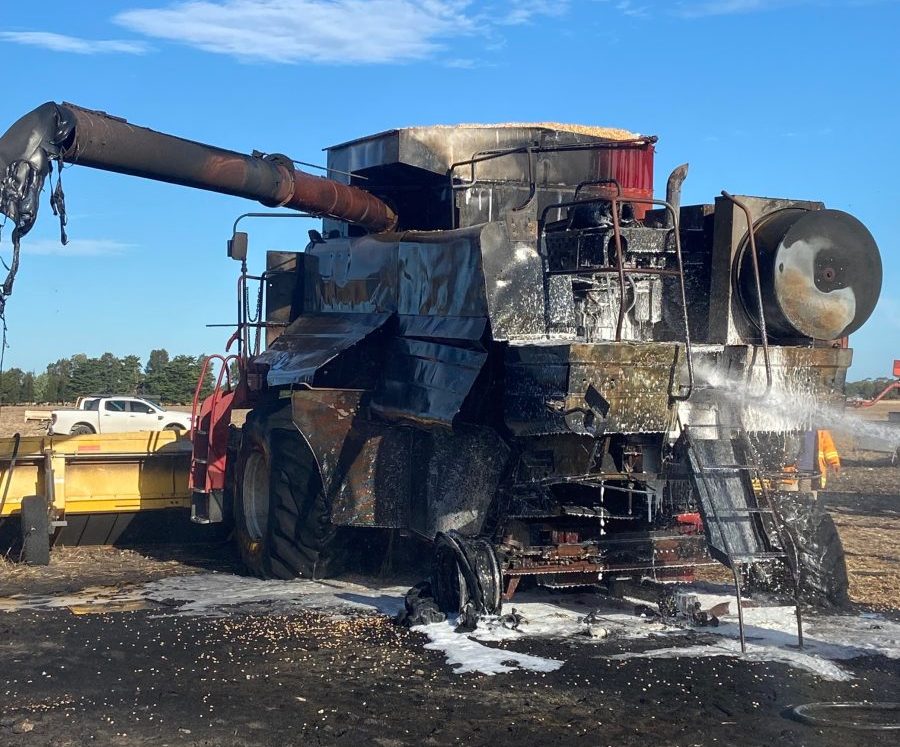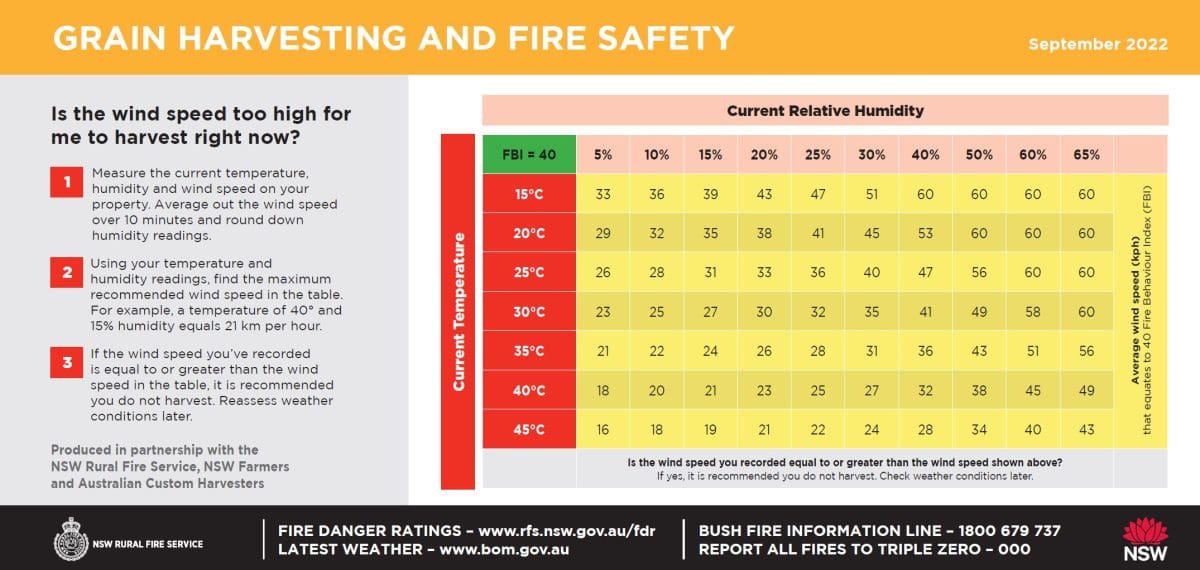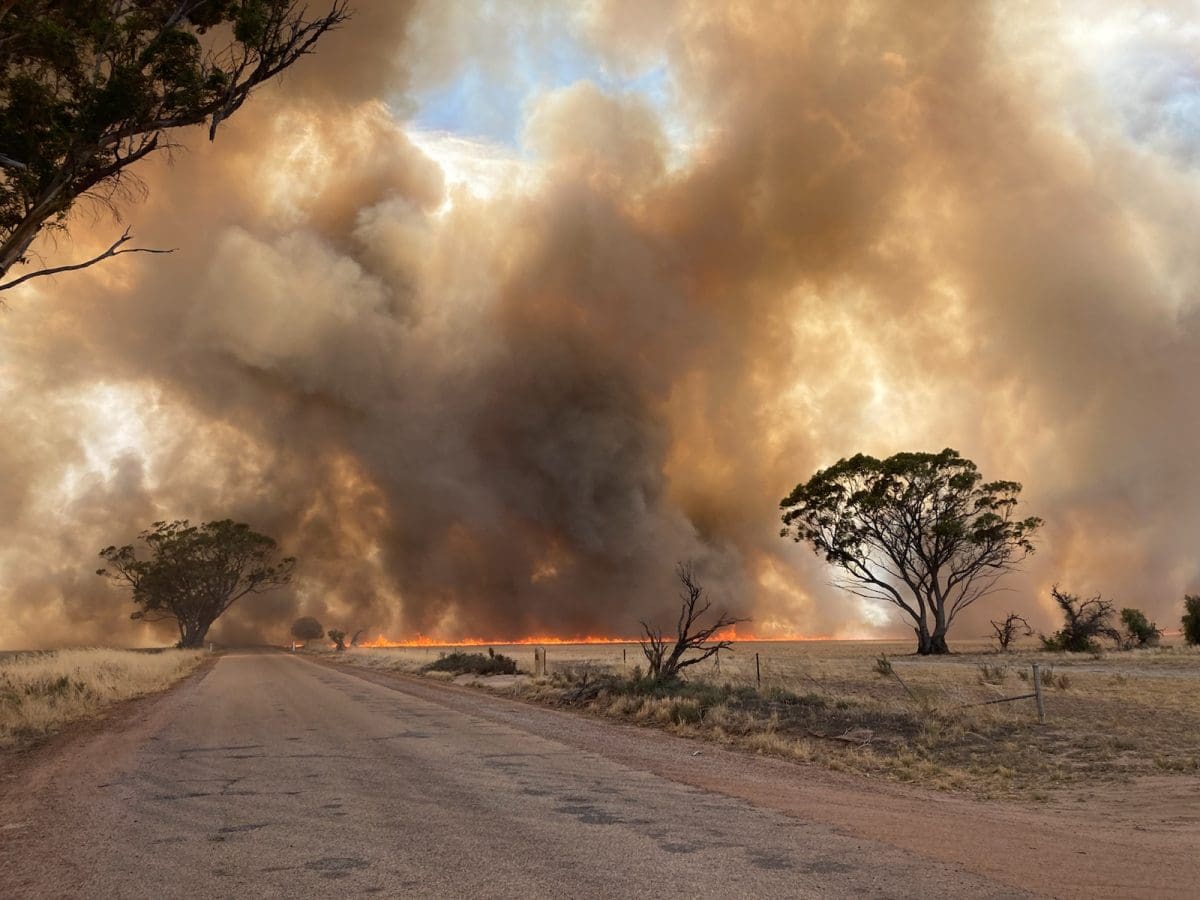
Fire destroys a number of headers each year, with this one at Maaoupe in SA’s South East a recent casualty. Headers are not the only cause of fires in grainbelt, but harvesting in hot and windy conditions is recognised as a significant fire risk Photo: Rachel Guy, SACFS
A CHANGE in the parameters used to determine when harvesting must cease due to fire risk is coming into force this year, and discussions are under way with state-based authorities to ensure growers, harvesters and brigades are across it.
In September last year, a new national Fire Danger Rating System came into effect to update the method introduced by CSIRO in the 1960s and expanded in the 1980s.
The change means harvesters can now be responsible for determining when they cease harvest due to excessive fire risk at a localised level, instead of relying on Total Fire Ban notices from state fire authorities.
Headers are far from the only cause of fires in the grainbelt, but a large number of machines are lost every harvest to fire which can tear through hundreds or thousands of hectares if not contained at the site.
Peak organisation Australian Custom Harvesters has worked with state fire authorities to develop guidelines that indicate when headers need to stop.
ACH president and Dubbo-based contractor Damien Talbot said handheld technology, as well as the NSW Rural Fire Service Grain Harvesting and Fire Safety Guide as the go-to for his home state, has provided a new degree of autonomy.
“No-one tells you when to stop any more; it’s up to you,” Mr Talbot said.
“Some states used to call a total fire ban because the wind speed was going to be up.
“Now it has a lot to do with common sense, and knowing when you should pull up.”

The NSWRFS Grain Harvesting and Fire Safety Guide allows harvesters to calculate when localised conditions require them to cease operations. Source: NSWRFS
The NSWRFS guide includes a table which shows the maximum wind speeds at which headers can keep rolling based on temperature and relative humidity.
It is available for header owners to print and display within the cab.
“I have one in every machine, and if the wind starts picking up, we stop.”
“It’s the only way you can cover yourself with insurance.”
Header read-outs and data available on mobile phones round out what is needed by harvesters to monitor conditions to ensure fire risk is minimised.
The Victorian Farmers Federation and Victoria’s Country Fire Authority have likewise come up with a similar easy-to-read table as part of the state’s voluntary guidelines.
Sources have told Grain Central that Western Australia, where some devastating fires have occurred in the Wheatbelt in recent years, is still grappling with how to use the index.
“There are some really high levels of concern out of WA that the new arrangements aren’t working for them,” one source said.
The WA Department of Fire and Emergency Services was contacted for comment.

Fire tears across wheat stubble at Bruce Rock in the WA Wheatbelt in February 2022 in an event that damaged an estimated 60,000ha. Photo: Leigh Strange
Consultation under way in SA
Discussions are under way in South Australia to determine a workable cease-harvest index number by mid-year in order to have all stakeholders on board ahead of the start of this year’s grain harvest.
This follows the transition from the Grain Fire Danger Index (GFDI) to the new Fire Behaviour Index (FBI) which had a soft roll-out last harvest in SA when the new national rating system came into effect.
“We’re meeting fortnightly to make sure we land agreement by the middle of the year,” SA Country Fire Service director of strategic operations Brenton Hastie said.
“Many of our volunteers are also farmers, so that makes the stakeholder consultation easier,” Mr Hastie said.
Discussions started ahead of the 2022-23 harvest, and are taking place within the Grain Harvesting Code of Practice Review Working Group.
This is chaired by former SA politician and agripolitician Rob Kerin, and includes representatives from Grain Producers SA, SACFS, SA Police, and Primary Industries and Resources SA.
In August 2022, GPSA was informed about a change in the GFDI cease-harvest index figure of 35 to the new FBI cease-harvest figure of 40.
“We have been seeking a resolution based on consistency with past practices from the SACFS,” Grain Producers SA chief executive officer Brad Perry said in a statement issued earlier this month.

GPSA CEO Brad Perry.
GPSA sought and was granted a delay in the roll-out of the FBI cease-harvest number last season.
“The working group is now exploring the assumptions behind the new FBI model and providing on-the-ground data to ensure a feasible working outcome for producers is reached.
“At the first meeting, the working group agreed the cease-harvest threshold must strike the right balance between managing the risk of fire and the operating requirements of grain harvesters.
“Farmers do not want to put their property, or their neighbouring properties, at risk.
“However, dry and hot conditions, which can be high risk for fire, are normal operating conditions for harvesting in Australian summers.”
Mr Perry said it was acknowledged that the transition from GFDI to FBI had not gone smoothly.
“There is a need to review the threshold to ensure that the new approach is consistent and appropriate.”
Mr Hastie said the FBI was based on new and improved science, and a more complex formula that reflects findings from the latest research on grassfire behaviour.
That includes the type and size of fuel loads, but sources have said the relationship between grain yields and stubble loads can throw a curved ball into the mix that generates an index figure.
“We learnt from last fire season that having bigger loads makes it more sensitive.”

HAVE YOUR SAY